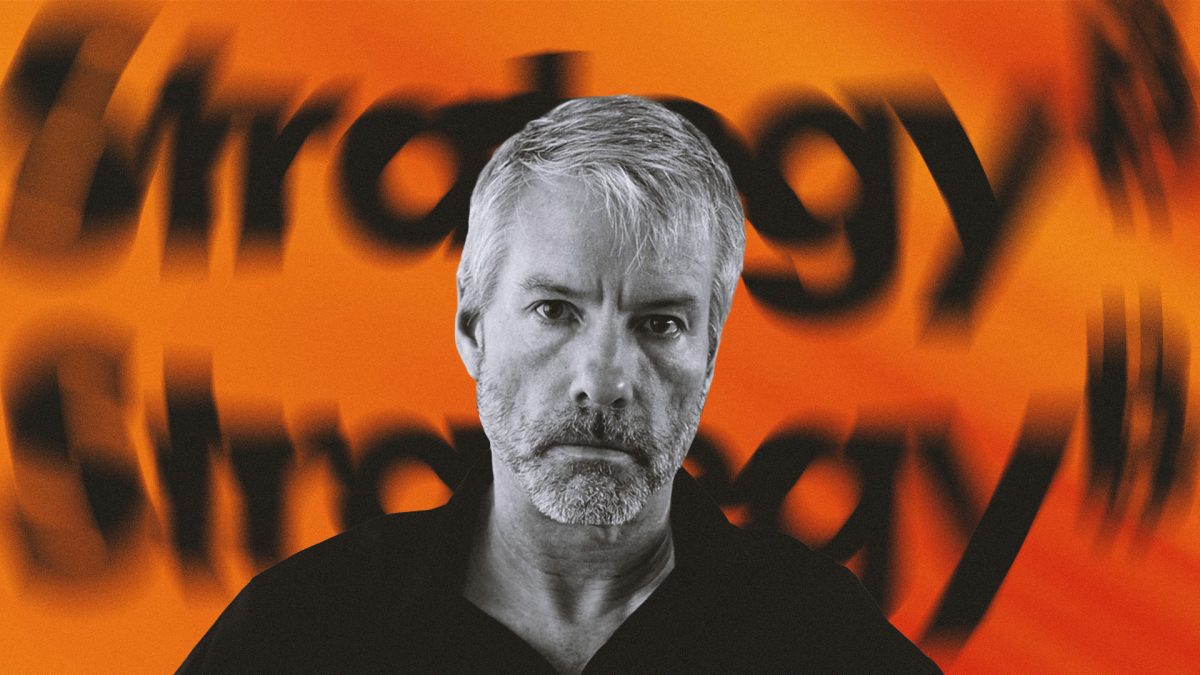With Trump's return to the White House, prediction markets are experiencing an unprecedented surge in mainstream adoption. The latest major news: Polymarket, the world's largest prediction market, has received tens of millions of dollars in investment from the venture capital fund of Donald Trump Jr., the president's eldest son. The president's son not only invested through 1789 Capital but will also join Polymarket's advisory board.
Polymarket's investment may also indicate that an IPO is far more likely than a token issuance. 1789 Capital, an investor in high-profile companies like Anduril and SpaceX, reportedly began discussions with 1789 Capital founder Omeed Malik and Polymarket CEO Shayne Coplan 18 months ago, but the formal investment wasn't made until the company had a clear legal path to the US market.
Another interesting observation is that most prediction market projects are still in the pre-coin issuance phase, leaving relatively limited options for secondary market investors. Even prediction market giants like Polymarket only directly invest in the UMA protocol, which provides oracle services.
Against this backdrop, BlockBeats has selected six promising projects in the prediction market sector. From Flipr, which achieved a 100x return in two months by embedding transactions into social media to achieve virality, to UMA and Azuro, which are building infrastructure to serve the entire industry, to emerging protocols that leverage AI algorithms to achieve fully autonomous trading decisions, these projects not only possess unique technical architectures but also demonstrate distinct development paths in terms of business models and user experience. It is important to note that this article is solely for industry analysis and information compilation and does not constitute investment advice.
Flipr: A social prediction market that grew 100 times in 2 months
Flipr is positioned as the "social layer for prediction markets." Its core innovation lies in embedding prediction market transactions into the X (Twitter) platform, allowing users to place bets without leaving the social timeline.
Users simply tag @fliprbot in a tweet and specify the direction and amount. The bot will interpret the instructions and execute the trade instantly. The executed order is automatically published as a quote tweet, allowing bets to be placed on Polymarket and Kalshi. Others can copy, reverse, or share the order with a single click. This design transforms traditional prediction markets from isolated website interfaces into a viral social experience, where every trade becomes naturally shareable content, significantly reducing user acquisition costs. Flipr also introduces features such as up to 5x leverage, stop-loss and take-profit orders, and advanced order types.
In terms of team and financing, as of August 2025, the identities of the project team members have not been publicly disclosed, and the project remains anonymous. No equity financing rounds or venture investors have been announced to date.
Regarding token economic data, according to Coingecko, as of September 1, 2025, the current price of $FLIPR is $0.009951, with a market capitalization of approximately $6.96 million. Notably, the token achieved a 100-fold increase from less than $2 million to a peak of $21 million in just two months, demonstrating strong market momentum. However, after reaching an all-time high of $0.02804 on August 25, the current price is down 64.5% from that peak, indicating a significant correction from the peak.
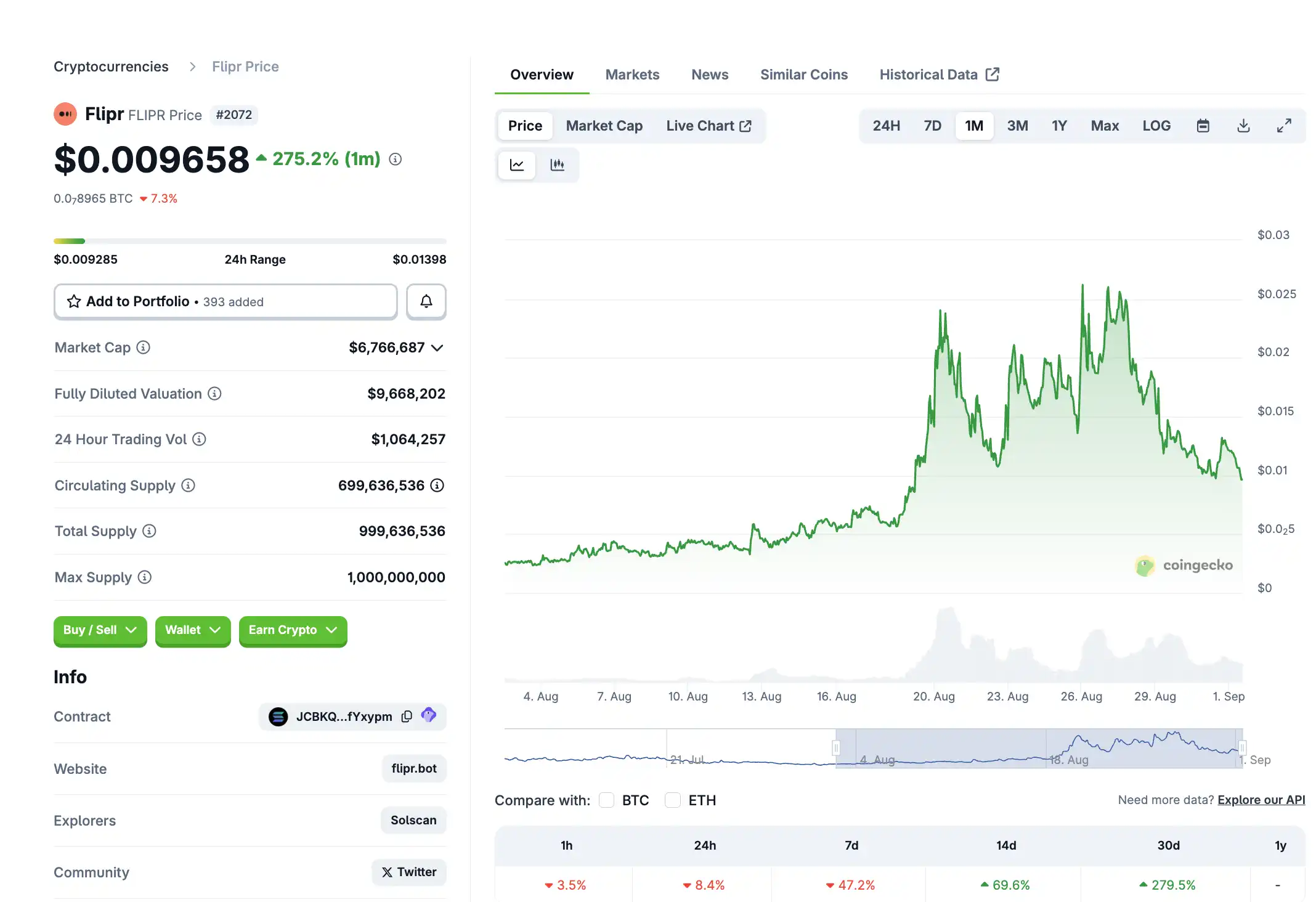
UMA: The King of Prediction Market Infrastructure
There is no need to explain much about UMA's status in the prediction market. Well-known protocols such as Polymarket and Across all use UMA as a dispute resolution method.
UMA (Universal Market Access) is positioned as an "optimistic oracle" protocol. Its core innovation lies in its two-tier architecture, consisting of an Optimistic Oracle and a Data Verification Mechanism (DVM). According to UMA's official documentation, the protocol utilizes a "presume correct first, verify disputes later" mechanism. Anyone can assert an external truth value on-chain and deposit a security deposit. If no one disputes it within a pre-set active period, the assertion is deemed correct. This design eliminates the need for voting in most cases, delivering results in seconds with minimal on-chain costs. Disputes are resolved through off-chain voting by UMA token holders within 48-96 hours.
Regarding financing, according to RootData, UMA has raised a total of $6.6 million since its launch in 2018, primarily in its early stages. A $4 million seed round in December 2018 was led by Placeholder, with participation from prominent institutions such as Coinbase Ventures, Dragonfly, Blockchain Capital, and Bain Capital Ventures. Notably, the project secured $2.6 million in funding in July 2021 through the innovative Range Token structure, providing a liquidity solution for the DAO treasury without selling pressure. Participants included professional institutions such as Amber Group, Wintermute, and BitDAO. Compared to emerging DeFi projects that frequently raise tens of millions of dollars, UMA's fundraising is relatively conservative, reflecting the team's emphasis on product-driven growth rather than capital-driven expansion.
UMA uses a staking mechanism to ensure network security. According to official documents, stakers lock their UMA in the DVM 2.0 contract to vote on oracle disputes, earning a target annualized yield of approximately 30% and redistributing funds forfeited from incorrect voters. On August 12th, UMA launched the "Managed Optimistic Oracle V2" contract for Polymarket, restricting market resolution proposals to whitelisted members.
With Binance adding UMA trading pairs on August 26, the market expects liquidity to further improve, but medium- and long-term performance still depends on whether it can effectively prevent token holder capture risks while maintaining the concept of decentralization.
As of September 1, 2025, $UMA was priced at $1.38, with a market capitalization of approximately $123.8 million. This represents an 8.9% increase in 14 days and a 13.8% increase in 30 days, demonstrating positive short-term performance. The token reached an all-time high of $41.56 on February 4, 2021. While the current price is down 96.7% from its peak, it has remained relatively stable recently.
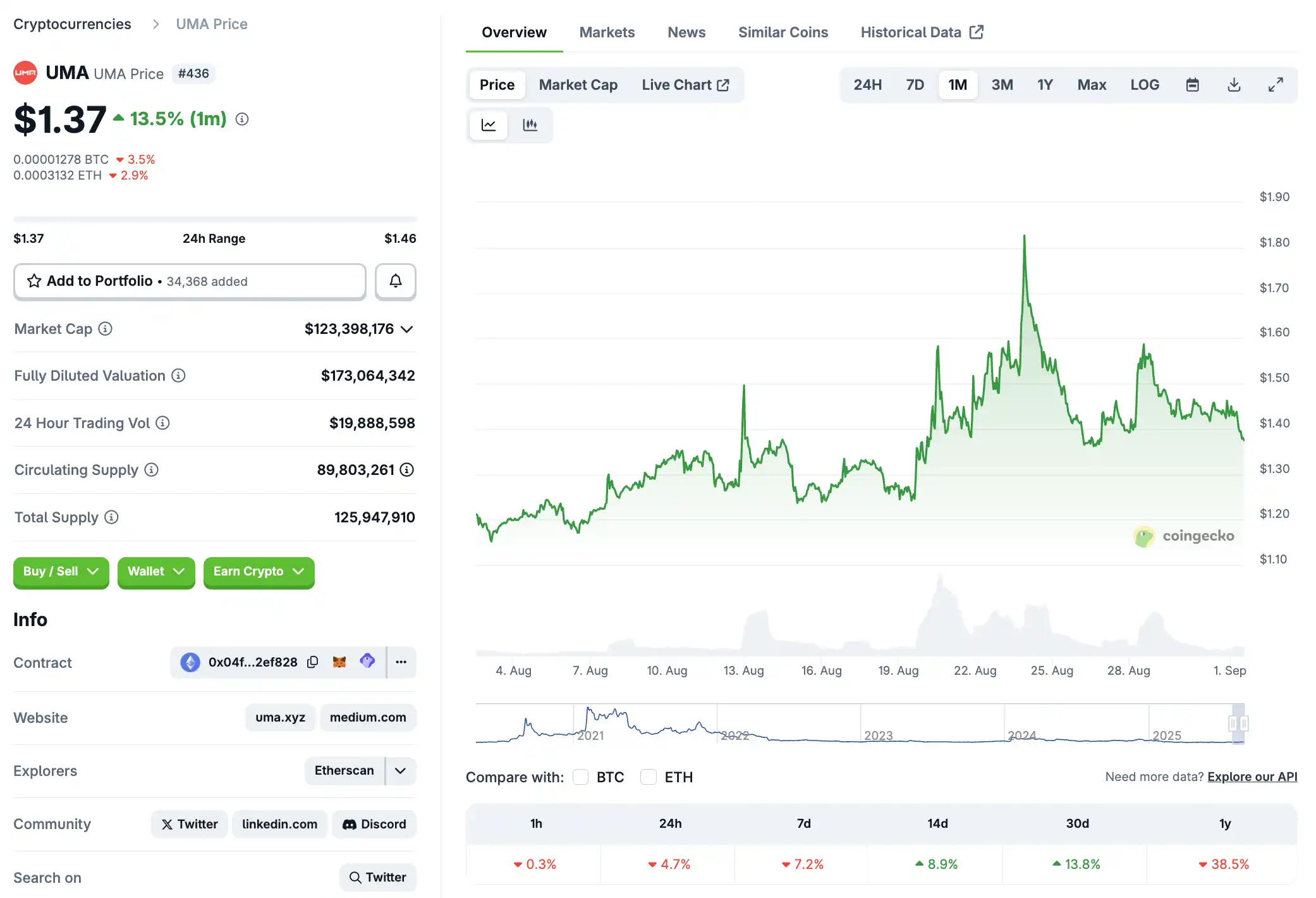
Augur: A Pioneer in Decentralized Prediction Markets
Augur is the first open-source decentralized prediction market protocol on Ethereum and can be said to be a pioneer in the decentralized prediction market.
Vitalik Buterin also mentioned Augur in an article about prediction markets last November: "I have been an active user and supporter of Augur since 2015 (my name appears in the Wikipedia article). During the 2020 US election, I earned $58,000 through betting."
The Augur protocol crowdsources reporting on the outcomes of real-world events through REP token holders. Inaccurate reports risk having their tokens slashed, while those reporting in agreement with consensus receive a share of platform fees. Even more uniquely, Augur incorporates a "fork to prevent consensus failure" mechanism. If a dispute cannot be resolved, REP holders can migrate to a new parallel universe, making attacks on the oracle extremely costly. It can be considered an alternative to UMA.
Augur was co-founded by three founders with deep technical and financial backgrounds. According to Forbes, co-founder Joey Krug, currently co-chief investment officer at Pantera Capital, became interested in prediction markets after developing a horse racing analysis spreadsheet. He ultimately designed Augur's game theory mechanism and led Ethereum's first ICO. The other two founders, Jeremy Gardner and Jack Peterson, are also active in the blockchain ecosystem. The project's advisory team includes industry heavyweights such as Ethereum founder Vitalik Buterin and Intrade founder Ron Bernstein.
In terms of financing history, the project conducted an ICO from August to October 2015, selling 8.8 million REP tokens at a price of US$0.602 per token, raising a total of approximately US$5.3 million. Major investors included well-known institutions such as Pantera Capital, Multicoin Capital, and 1confirmation.
$Augur is experiencing a community-led recovery, according to market feedback. While developing liquidity incentives and new research directions, it faces challenges related to insufficient liquidity, resulting in weaker performance compared to earlier prediction market platforms. As of September 1, 2025, the REP price is $1.05, with a fully vested total supply of approximately 8.06 million REP, resulting in a market capitalization of $8.5 million. This represents a 30-day increase of 41.2% and a one-year increase of 178%.
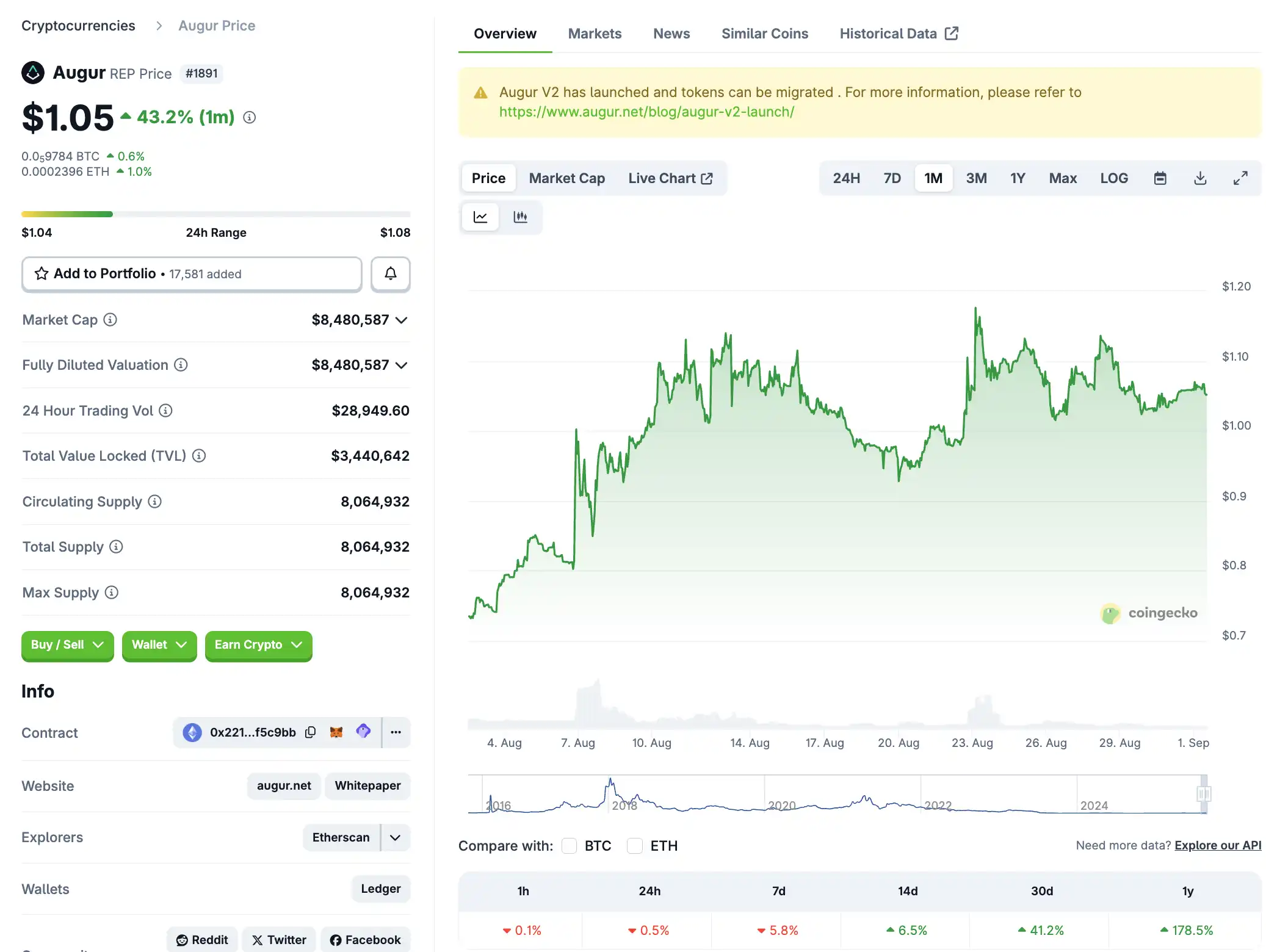
Azuro: A team from the traditional gaming market
Azuro is positioned as an open, white-label infrastructure layer, allowing anyone to launch on-chain sports and event prediction applications in minutes. According to official technical documentation, the protocol builds a complete prediction market technology stack through three plug-and-play modules: a singleton liquidity pool (which allows applications to access a common pool and pay fees, while limited partners earn floating returns and share in the bookmaker's profits and losses); a data provider/oracle layer (which allows approved data providers to create "conditional" markets and set initial capital and margin requirements); and front-end hooks (ready-made React components that allow branded sportsbooks or prediction games to launch without a backend). This design establishes Azuro as the "Shopify of sports betting," allowing front-end applications to retain their own UI/UX and pay a share of betting profits and losses to the protocol, while avoiding licensing and pool requirements.
The protocol's technical advantages lie in its LiquidityTree virtual automated market maker (vAMM) and shared singleton LP architecture. This system handles odds setting, liquidity management, oracle data, and settlement processes, eliminating the need for front-end developers to build their own trading engines. According to its official website, as of August 2025, Azuro supports over 30 real-time applications, with cumulative betting volume exceeding $530 million and approximately 31,000 unique wallets participating. Compared to traditional sports betting, its permissionless liquidity and transparent on-chain settlement provide front-end developers with competitive fixed odds while significantly lowering the barrier to entry. The protocol currently runs on four chains: Polygon, Base, Chiliz, and Gnosis, with Polygon holding a dominant position. This demonstrates that Azuro has garnered significant positive attention and strategic positioning within the Polygon ecosystem.
Azuro's team is led by a founder with a deep background in the traditional gaming industry. Founder and CEO Paruyr Shahbazyan, formerly the founder of Bookmaker Ratings, has over 10 years of experience in the iGaming industry. Azuro has raised a total of $11 million across three rounds of funding, with investors including Gnosis, Flow Ventures, Arrington XRP, AllianceDAO, Delphi Digital, and Fenbushi.
As of September 1, 2025, $AZUR has a total supply of 1 billion, with 222.95 million (22%) in circulation, a price of $0.007894, and a market capitalization of approximately $1.81 million. The token reached an all-time high of $0.2396 on July 20, 2024. The current price is down 96.6% from that peak, but has recently shown strong rebound momentum, with a 24-hour increase of 41.5% and a 7-day increase of 41.8%.
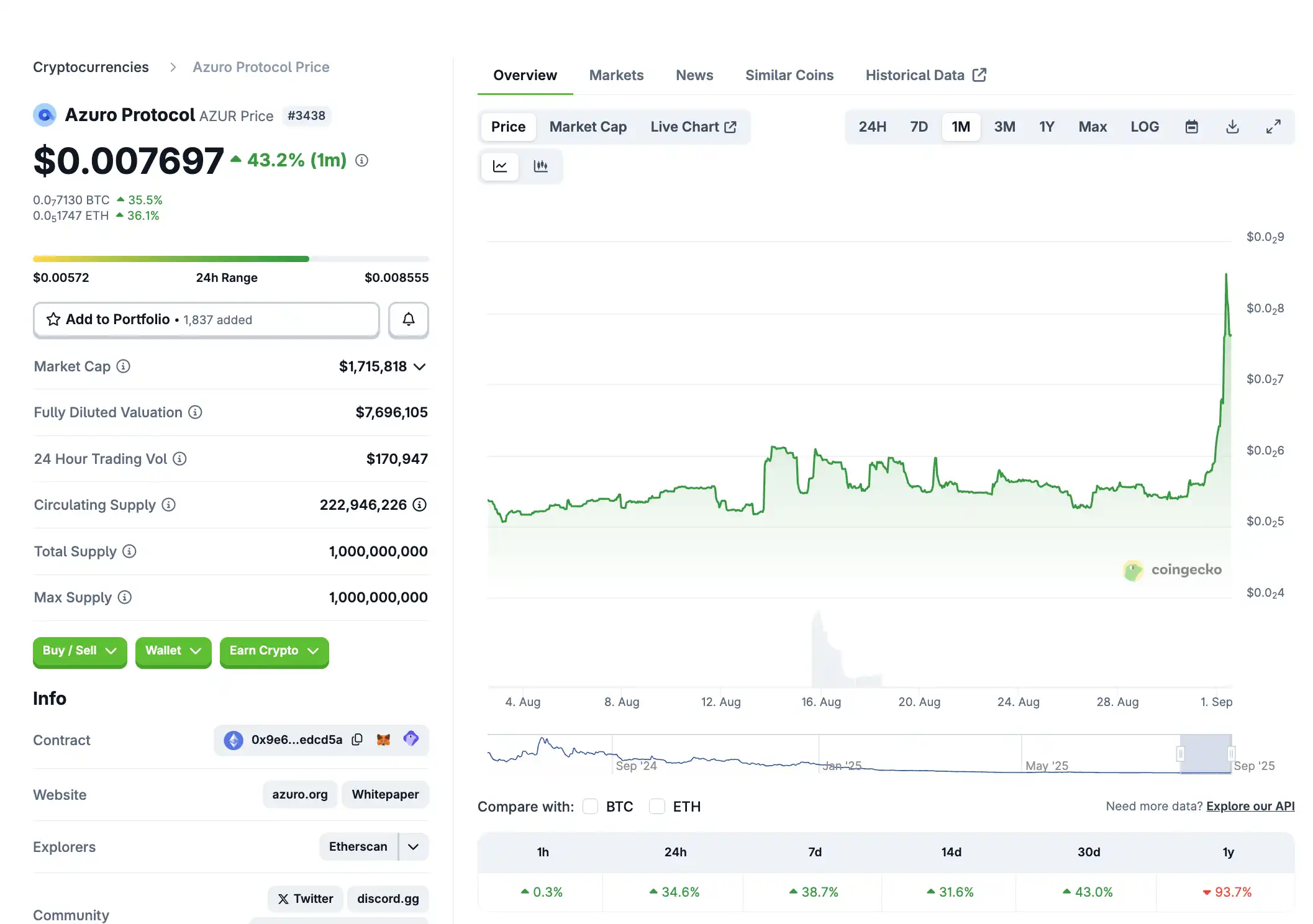
PNP Exchange: A Permissionless Prediction DEX on Solana
PNP Exchange is positioned as a permissionless prediction market DEX on the Solana chain. Its core innovation is that any user can create a yes/no market on "any conceivable topic" and earn 50% of transaction fees from its bonding curve pool. According to the project's official website, the platform uses an automated bonding curve pricing mechanism to achieve instant on-chain settlement. Innovatively, PNP integrates the LLM oracle system, using Perplexity and Grok consensus combined with on-chain data sources to automatically resolve market outcomes. It has successfully completed the settlement of its first token market without human intervention.
The protocol's recently launched "Coin MCP" module demonstrates its rapid technological iteration, allowing users to create prediction markets with one-hour settlement for any token's price, liquidity, or market capitalization. According to a social media announcement by the project's founders on August 28th, the upcoming SDK will allow AI agents to programmatically create and trade markets, while gas costs will drop by 90% over the next 2-3 days. This "Pump.fun-style prediction market" differentiates itself from traditional platforms like Kalshi and Polymarket by removing the barrier to listing, making it a meme-driven prediction trading platform driven by user-generated content.
The $PNP token is designed to be fully liquid, with a total supply of approximately 965 million. According to Birdeye data, as of September 1, 2025, the token price was $0.001665, with a market capitalization of approximately $1.6 million. It has risen 148.8% in 30 days, with a 24-hour trading volume of $176,000, all of which is traded on the Meteora DEX.
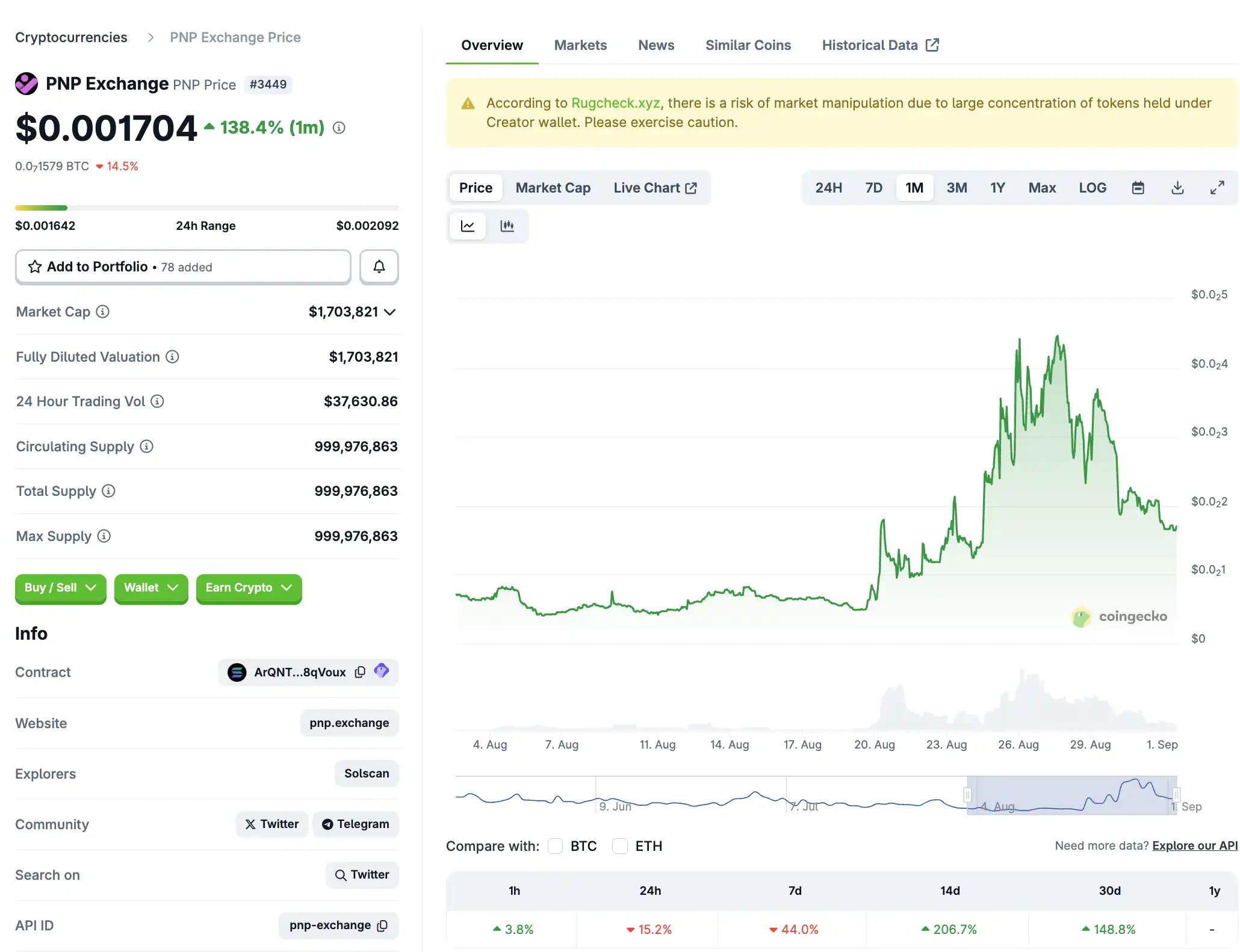
Hedgemony: AI-powered autonomous trading algorithm
Hedgemony is positioned as a "fully autonomous AI trading algorithm" that specializes in real-time predictive trading based on global news and political sentiment. According to DexScreener, the algorithm crawls approximately 2,500 real-time news and political information sources per second, including tweets from Trump's account X, Bloomberg, Reuters, and national media outlets.
Hedgemony uses a Transformer language model with millisecond latency to detect directional bias in global macro news headlines, enabling it to execute high-frequency leveraged futures trades within a time window of up to 60 seconds before the information is publicly disseminated.
The protocol's innovation also lies in its "Intention-Driven Execution Layer" design. According to the official introduction, Hedgemony provides users with an AI agent capable of assembling swap routing, dollar-cost averaging, income delegation, and narrative-based portfolio strategies through prompted input. The system is currently running in MVP on Arbitrum, with plans to expand to Base, HyperEVM, and Monad Networks.
Regarding financing, Hedgemony completed an extension of its seed round, reporting a valuation of approximately $1 billion, though the exact amount raised was not disclosed. It's important to note that this valuation claim has not been corroborated by independent media reports or disclosures of vested interests in the blockchain industry. Investors should approach such valuation figures with caution, especially given the project's early stages of development.
Regarding token economics, $HEDGEMONY has a total supply and circulating supply of 1 billion tokens, with a fully circulated design. As of September 1, 2025, the token price was $0.005306, with a market capitalization of $5.3 million, and a fully diluted valuation equal to the market capitalization. The 7-day gain of 64% demonstrates positive short-term performance.
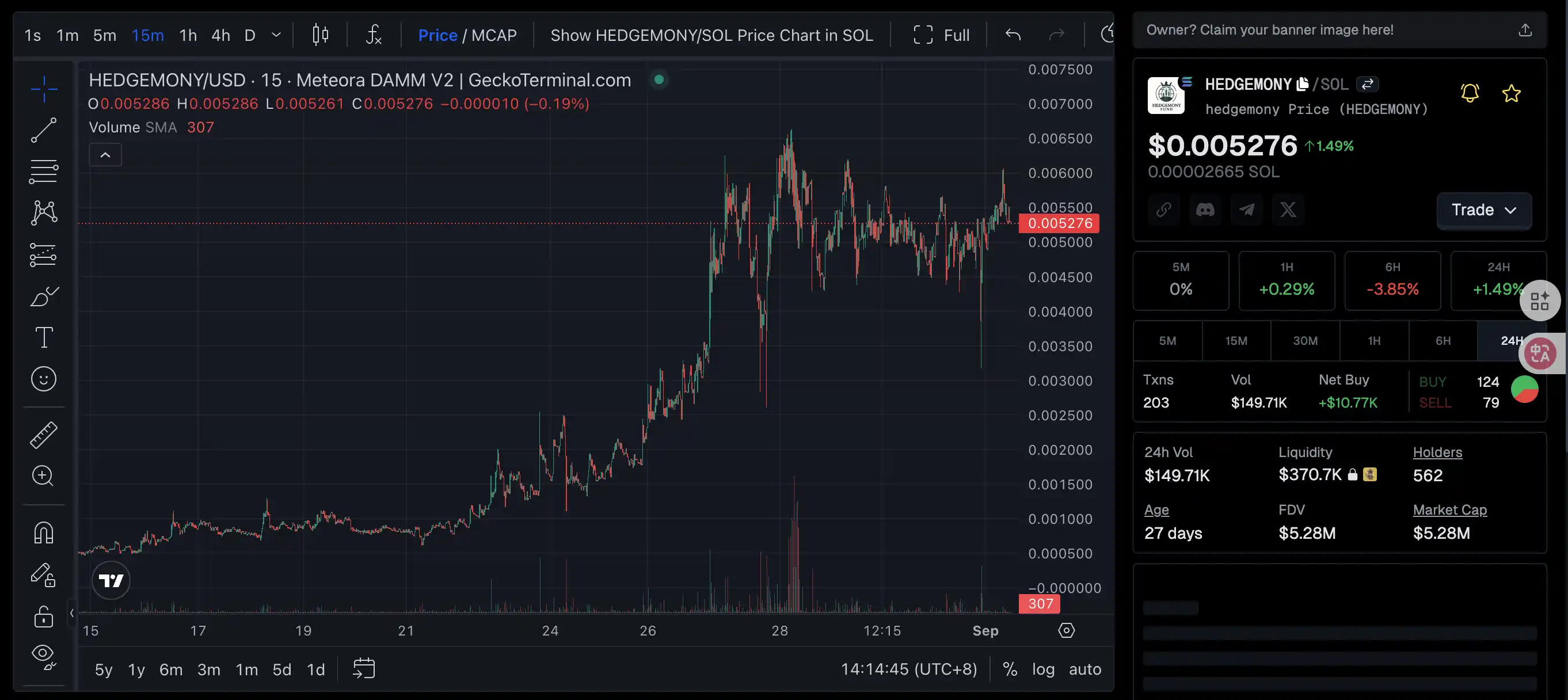
On-chain data shows 557 holding addresses, with a total liquidity pool of $371,000 USD. Within 24 hours, 251 transactions were conducted by 78 unique trading addresses. Notably, the top 10 holdings account for a staggering 66.57%, with the largest address holding approximately 50% of the total, indicating significant concentration risk. The project is still in its early stages of speculative adoption, characterized by a highly dynamic risk-return dynamic.









